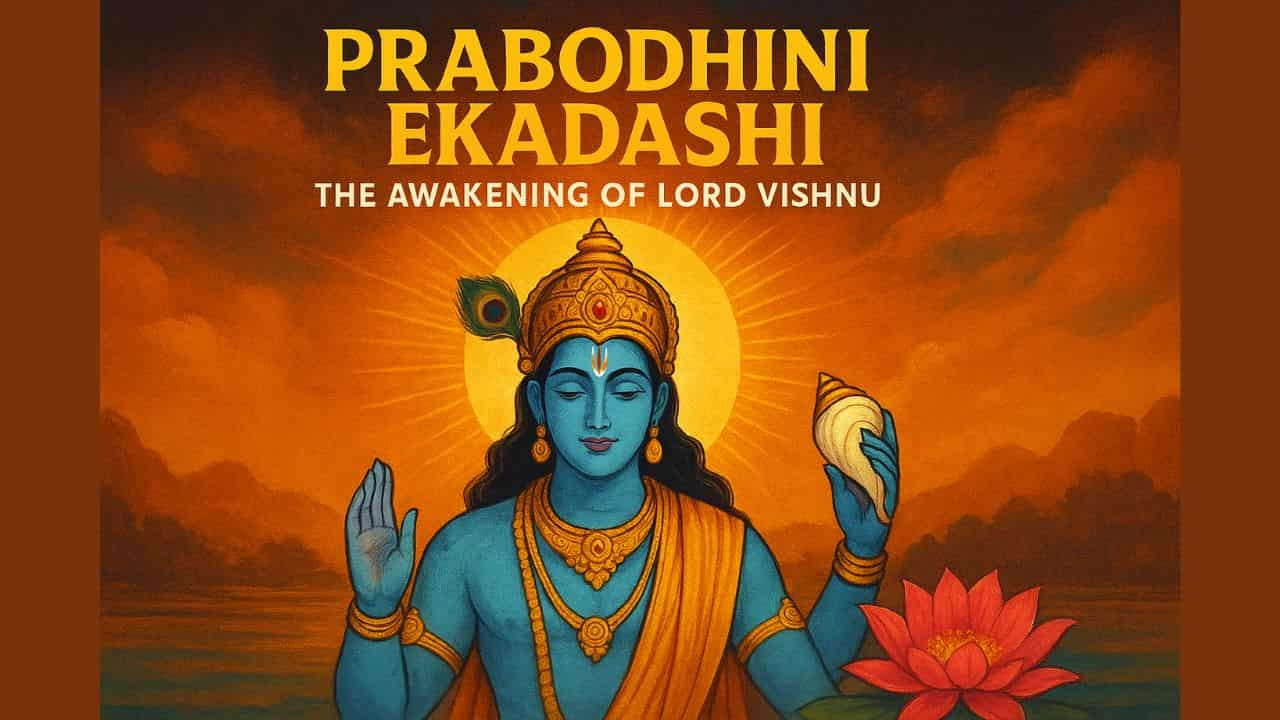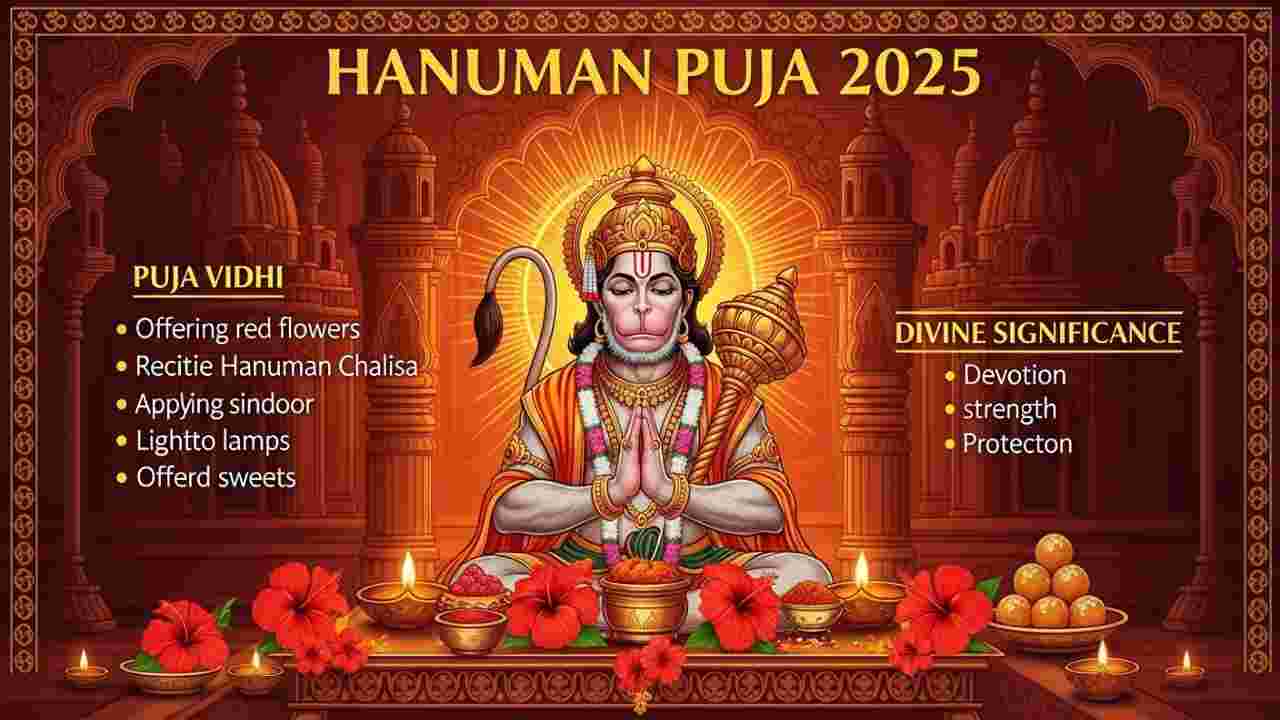
Prabodhini Ekadashi 2025: Details
- The Dev Uthani Ekadashi Tithi begins on 1 November 2025 at 09:11 AM
- It ends on 2 November at approx. 03:23 PM for Parana (the time to break fast).
- Another listing also shows that Prabodhini Ekadashi tithi in Shukla Paksha of Kartika is from Nov 01, approx. 12:42 pm to Nov 02, approx. 11:02 am for some regions.
Prabodhini Ekadashi: The Festival of Awakening
Prabodhini Ekadashi, also known as Dev Uthani Ekadashi, marks an important spiritual turning point in the Hindu calendar. Falling on the eleventh day (Ekadashi) of the bright fortnight in the month of Kartika (October-November), it signifies the day when Lord Vishnu awakens after four months of deep yogic sleep, known as Chaturmas.
For devotees, this day is not just a ritual date but a moment of renewal, hope, and devotion. With Lord Vishnu’s awakening, the spiritual energy of the world is believed to surge, and auspicious activities such as marriages, housewarmings, and other ceremonies resume.
This festival, while rooted in mythology, resonates with modern life by symbolizing the importance of rest, renewal, and mindful re-engagement with the world. Just as Lord Vishnu awakens to restore balance, we too are reminded of the cycles of rest and action that govern human existence.
Mythological Background: Vishnu's Cosmic Sleep
According to Hindu tradition, Lord Vishnu, the preserver of the universe, enters a state of cosmic sleep (Yoga Nidra) on Devshayani Ekadashi, which falls in the month of Ashadha (June-July).
During this four-month period known as Chaturmas, the universe is symbolically at rest. No auspicious ceremonies, such as weddings, are performed, and devotees focus on prayer, fasting, and spiritual discipline.
On Prabodhini Ekadashi, Vishnu awakens, signaling the resumption of worldly and spiritual activities. This divine slumber and awakening reflect cosmic cycles of rest and renewal, reminding us that even the divine follows a rhythm of pause and action.
The festival is also closely tied to the story of King Bali, a powerful demon king known for his generosity. According to the Vamana avatar story, Vishnu, in the form of a dwarf Brahmin, asked Bali for three paces of land. With his first two steps, he covered the earth and sky, and with the third, he placed his foot on Bali’s head, sending him to the netherworld. Impressed by Bali’s devotion and humility, Vishnu granted him the boon of visiting his people once a year. This day is celebrated as Dev Uthani Ekadashi in many regions, blending myth with devotion.
Rituals and Traditions of the Day
On Prabodhini Ekadashi, devotees wake up early, bathe, and offer prayers to Vishnu, often in the form of Shaligram stones or idols. The rituals include decorating temples and homes with lights, flowers, and rangolis.
Special pujas and fasts are observed, with devotees abstaining from grains, pulses, and certain vegetables, choosing instead to consume fruits, nuts, and milk-based foods.
One of the unique rituals involves preparing a symbolic “Tulsi-Vishnu Vivah,” where the holy basil plant (Tulsi) is ceremonially married to Lord Vishnu. This marks the beginning of the Hindu wedding season.
Women especially take part in this ritual, dressing Tulsi plants as brides, preparing mandaps (canopies), and performing rituals as if conducting a real wedding. The Tulsi Vivah highlights the sanctity of marriage, devotion, and harmony in household life.
In regions like Gujarat and Maharashtra, processions and fairs are organized, with devotees singing bhajans, dancing, and celebrating Vishnu’s awakening with joy.
The Fasting Practice: Discipline and Devotion
Fasting forms a core part of Prabodhini Ekadashi. Devotees either observe nirjala fasts (without food and water) or consume light, sattvic meals like fruits and milk.
The fast is not merely physical discipline but a way to purify the mind and focus on spiritual growth. By abstaining from indulgent foods, devotees practice self-control and remind themselves of the importance of moderation in life.
The fast is also accompanied by chanting Vishnu mantras, reading scriptures like the Vishnu Sahasranama, and performing charity. In many traditions, devotees break their fast on the following day, Dwadashi, with food first offered to Brahmins, cows, or the poor before being consumed.
Symbolism of Vishnu’s Awakening
On a deeper level, Vishnu’s awakening represents the reawakening of consciousness and awareness within ourselves. Just as the divine rests and renews, human beings, too, need cycles of introspection and action.
The Chaturmas period of rest parallels our own need to pause, reflect, and recharge. Prabodhini Ekadashi becomes a metaphor for stepping out of inertia and re-engaging with purpose and clarity.
For individuals, this festival is a reminder that life is not a constant race. Just as Vishnu awakens refreshed, we too must learn to balance rest with action, spirituality with material life. It highlights the importance of mindful living, acting with renewed energy after periods of reflection.
Regional Variations and Celebrations
Prabodhini Ekadashi is celebrated differently across regions of India.
- In Gujarat, the day is marked by the Tulsi Vivah with grandeur.
- In Maharashtra, fairs and processions are common, often centered around temples like Pandharpur, dedicated to Lord Vithoba (a form of Vishnu). Devotees gather in large numbers, singing abhangs (devotional songs) and performing kirtans that celebrate Vishnu’s glory.
- In North India, the day also connects with rituals honoring King Bali, emphasizing humility, surrender, and the balance between power and devotion.
- In temples across Varanasi, Vrindavan, and Mathura, special Annakut offerings (mountains of food) are also made to Vishnu.
- The festival is not limited to India. In Nepal and among diaspora communities abroad, Vishnu temples conduct pujas, community feasts, and Tulsi Vivah ceremonies, allowing devotees to stay connected to their cultural and spiritual roots.
The Tulsi Vivah: More than a Ritual
The Tulsi Vivah ritual, central to Prabodhini Ekadashi, carries deep symbolism. Tulsi is revered as sacred, embodying purity, devotion, and protection. By marrying Tulsi to Vishnu, devotees symbolically unite the human world with the divine. The ritual also highlights the interconnection between nature and divinity, as a humble plant becomes the bride of the preserver of the universe.
From a modern perspective, the Tulsi Vivah underscores the importance of harmony in relationships. It reminds us that sacredness exists not just in temples but also in daily household life. By honoring Tulsi, a common plant, the ritual elevates the ordinary into the divine.
Spiritual Lessons for Modern Life
Prabodhini Ekadashi offers timeless wisdom applicable even today. In a world where burnout, restlessness, and anxiety are common, the festival teaches the importance of cycles, resting, reflecting, and then acting with renewed strength. Just as Vishnu does not abandon the world but temporarily rests, we too are called to step back without giving up, to pause without losing hope.
The fasts encourage moderation, a quality often lost in today’s culture of excess. By simplifying food and life for a day, devotees experience clarity and gratitude. The rituals of Tulsi Vivah emphasize respect for nature, devotion in relationships, and the sanctity of family life, values that modern societies deeply need.
Dev Uthani Ekadashi: The Eternal Awakening
Prabodhini Ekadashi is more than a festival; it is a metaphor for life itself. It marks not just Vishnu’s awakening but our own awakening to higher consciousness, gratitude, and balance.
The day connects mythology with lived practice, inviting us to see divinity in cycles of rest and renewal. Through fasting, rituals, and devotion, devotees reaffirm their relationship with the divine and with life itself.
In celebrating Prabodhini Ekadashi, we celebrate the possibility of awakening every day, awakening to compassion, awareness, and the divine presence within and around us. The festival assures us that no matter how long the night of rest, the dawn of renewal always comes.

